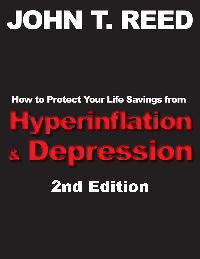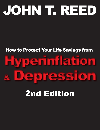Are you rearranging the investment deck chairs on your own Titanic?
by John T. Reed

 |
$34.95 |
Icebergs first; deck chairs second
The investment/business world is divided into three areas: skill, good luck, and bad luck.
Is seeking skill a worthwhile endeavor? Yes, if you do it competently. Is trying to become skilled at activities that are entirely luck a waste of time? Yes, by definition.
However, bad luck can be to your investment strategy what the iceberg was to the arrangement of deck chairs on the Titanic.
Arranging deck chairs on a cruise ship is undoubtedly a worthwhile activity—generally. But it is obviously an appalling waste of time if the cruise ship in question is rapidly sinking at the time.
Although it is by definition impossible to become skilled at things that are controlled by luck, one can become skilled at risk management with regard to the luck possibilities.
Hyperinflation and deflation
I just spent several years trying to get a handle on hyperinflation and deflation. Those efforts are now contained in my new book How to Protect Your Life Savings from Hyperinflation & Depression.
My conclusion is that no one can forecast or control either hyperinflation or deflation. I used the word depression rather than deflation in the title because the American public understands that word better and knows depression can happen. They tend to view deflation as a theoretical possibility that has never happened.
Skill means either forecasting the incidence of some event or controlling its incidence. Passive investments (stock, bond and comodity exchange stuff) skill consists of forecasting future prices.
Controlling events is more private equity than passive securities investing. Real estate investment is another area where investors typically have much management control over the performance of their asset.
Risk management combined with skill
What skill seekers need to remember is, “If you cannot forecast or control a pertinent variable, you must risk manage it.”
I cannot forecast either hyperinflation or deflation to any degree of accuracy. Neither can anyone else notwithstanding the widespread delusion that they can. But I do know that hyperinflation and deflation are possible. I also know that they are financially devastating if and when they happen.
It is also clear that whatever the unknown probability is, breathtaking unending federal deficits are increasing that probability.
Investors who own homes think properly about the risk of fire. The probability of a fire loss at your home is low, yet you have fire insurance. Why? Because although the probability is low, the financial cost of a fire would be devastating and the cost of the insurance is relatively low—because of the low probability actually. Low probability is not a risk-management technique. It is premium-setting data.
Yet most Americans currently are pursuing investment and business activities naked of any protection against hyperinflation or deflation. Say you discover a mispricing of 47-month-old, Montana subprime CDOs and bet your entire net worth that the market will wise up and reprice that asset correctly in a year. Further say that you are right.
What will it matter if during that same year the world bond market loses confidence in the dollar and the Fed reacts by printing trillions of them to “buy” U.S. bonds? From the standpoint of hyperinflation risk management, your brilliant bet is merely a dollar-denominated asset and during hyperinflation, a profitable dollar-denominated asset is about as useful as a good deck chair arrangement on a sinking cruise ship.
When skill is irrelevant
There used to be a TV commercial that had the line, “When you’ve got your health, you’ve got just about everything.” That is actually incorrect, but the converse is true. “If you don’t have your health, nothing else matters much.”
A similar statement can be made about dollar-denominated asset skill during hyperinflation. Figuring out how to make a dollar-denominated arbitrage profit during hyperinflation matters not because during hyperinflation, the dollar loses all value. Having a million worthless dollars is no better than having $800,000 worthless dollars. Indeed, the end point in hyperinflation is the replacement of the currency in question with a totally new currency backed by some hard asset., e.g., the German Rentenmark in 1923.
Step one in the Titanic analogy is don’t hit an iceberg. Step two is arrange the deck chairs optimally. Step one in seeking investment skill is protect yourself from hyperinflation. Step two is seek skill.
The Spockian logic and rationality that defines competent investment skill seekers requires both a big-picture and a fine-grain perspective. “Vacuuming up nickels,” to use a phrase quants made famous on Wall Street, on the beach is normally a profitable activity, but not if a tsunami arrives while you are doing it. The appropriate-as-far-as-it-goes microscopic focus of investment skill seekers can blind them to big-picture risks like hyperinflation and deflation—risks that overwhelm arbitrage opportunities.
The main objection I get to hyperinflation risk management is people throw up their hands and say there is nothing you can do about hyperinflation. They claim it means Armageddon, rioting in the streets, and defending your survivalist cabin with your stockpile of ammo. Actually, the empirical evidence is that no such thing has happened during the world’s many bouts of hyperinflation. Those hurt by hyperinflation are generally seniors and rich people—groups not known for their rioting and looting
Hyperinflation risk is finite and manageable. Throwing up one’s hands is un-skill-like, unnecessary, and unwise.

